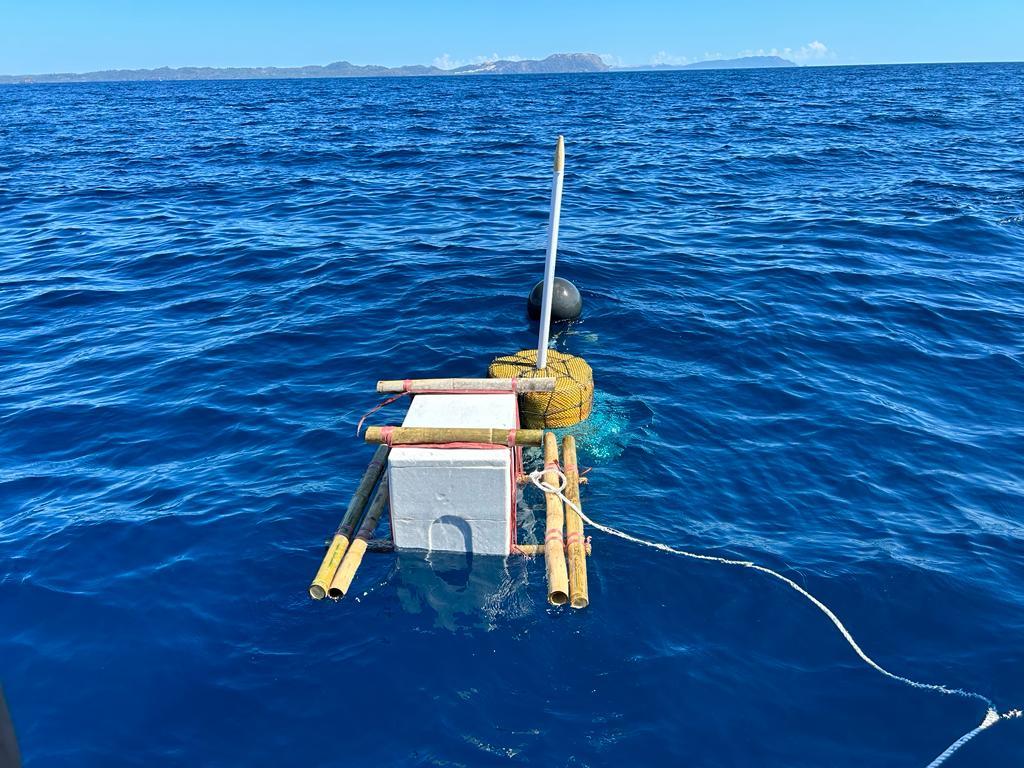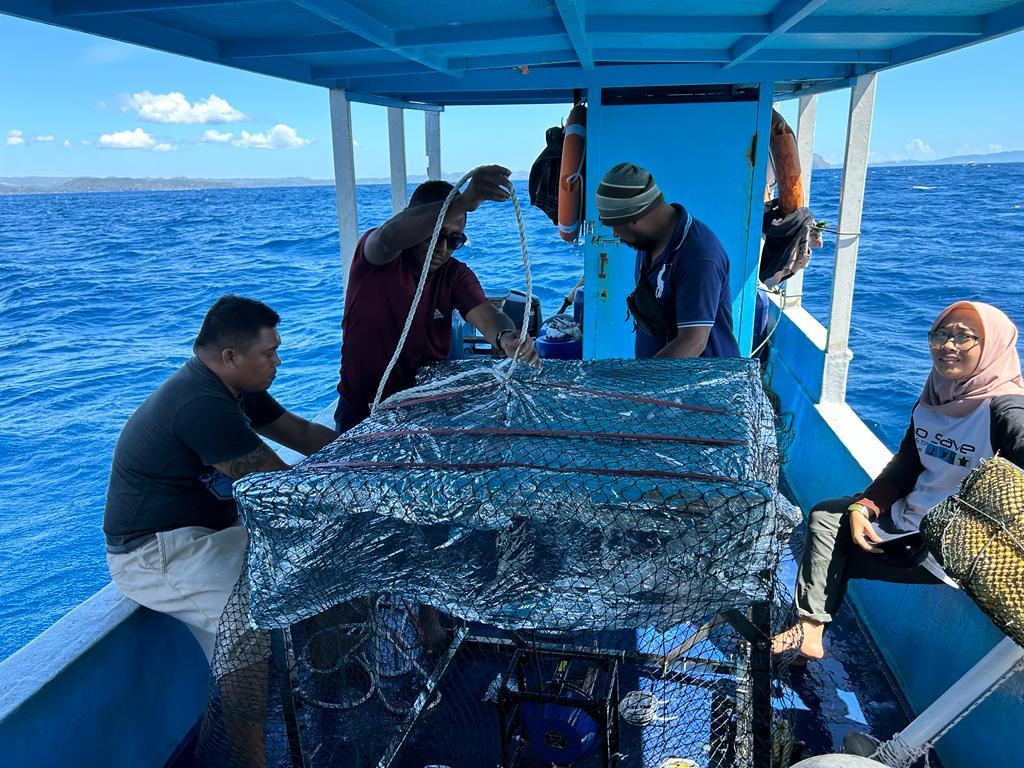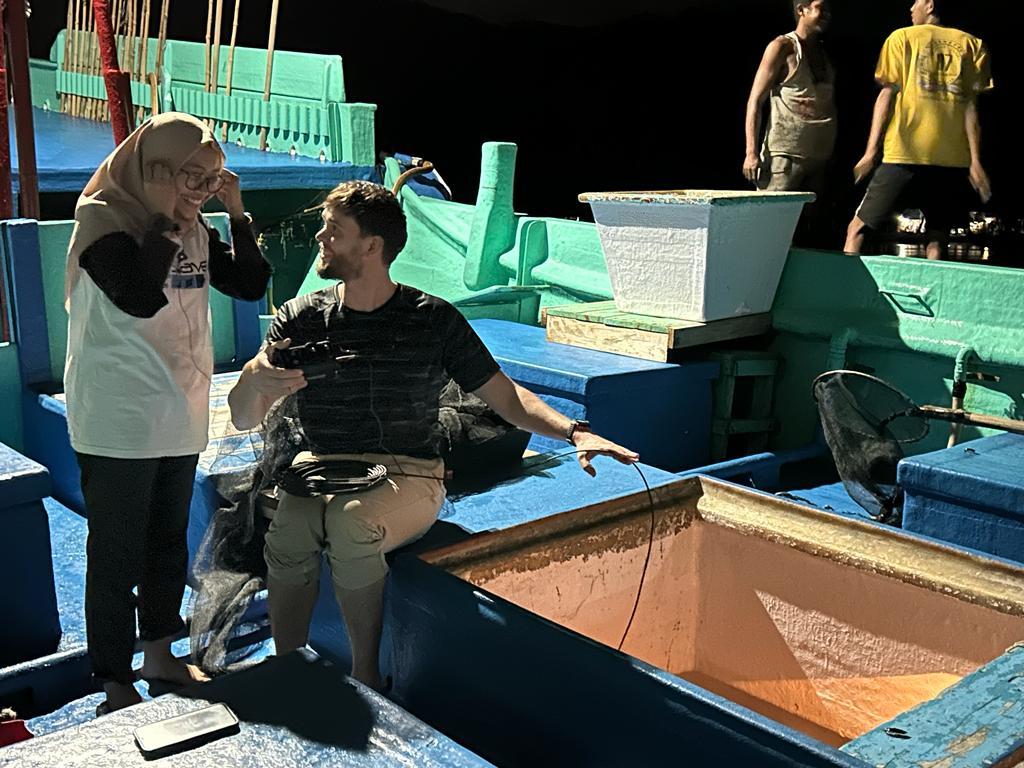Sustainable food system case study

The experimental rig consists of a cage underwater with SNTech’s programmable lights, and underwater speaker and reflective material, with a large buoy and battery set-up housed in the polystyrene box to power the underwater speakers. Credit - IPNLF.
A case study for a sustainable food system
The International Pole and Line Foundation (IPNLF) is the global charity that works to support, develop, and promote the world’s responsible pole-and-line, handling, and troll (collectively known as ‘one-by-one’) tuna fisheries whilst also recognising the importance of safeguarding the livelihoods they support. IPNLF’s work to develop, support, and promote one-by-one tuna fisheries fully aligns with the 2030 Agenda for Sustainable Development.
A sustainable food production system
Pole-and-line fishing, also referred to as ‘one-by-one’ fishing, entails using one hook and one line to catch one fish at a time. It is a traditional low-impact fishing method that has been used for millennia in coastal communities throughout the Pacific, Indian, and, more recently, Atlantic Oceans.
Pole-and-line fishing is regularly recognised as the most sustainable fishing technique because of its capacity to catch commercially viable volumes of tuna while being highly selective with little to no bycatch when compared to other fishing gear types. Furthermore, because each pole requires its own expert fisher, pole-and-line vessels create more employment opportunities thereby stimulating local economies in coastal communities. Local jobs are also created in distribution, processing, and infrastructure.
These fisheries play an important role in global tuna supply chains, especially given the increased demand for ethically sourced and environmentally conscientious seafood. The catch from pole-and-line fishing helps to secure local food while also entering worldwide value chains for canned tuna, which is a staple protein for global food security. Tuna fishing is a means to overcome poverty and as a result, the lifespan of tuna populations, and thus the health of the ocean ecosystem, is critical to these people and the fate of their children.

Bait fish
During a pole-and-line fishing operation, small demersal (‘groundfish,’ living near the bottom of the sea) and pelagic (living neither near the bottom nor the top of the sea but rather in the mid, ‘pelagic’ zone) forage fish species are thrown into the water in a process called ‘chumming.’ The chumming elicits a feeding response from tuna towards the surface near the fishing vessel, allowing the fishers to catch the tuna one at a time.
These forage/ bait fish species are globally harvested for fish meal and fish oil and for direct human consumption in enormous quantities. In some areas, these bait fish species have been so extensively overfished that it leads to the collapse of the bait fish fishery which in turn leads to the collapse of the associated pole-and-line fishery, such as in Cabo Verde.
In Indonesia where the Darwin Initiative Innovation project is now based, obtaining live bait fish is one of the biggest operational challenges facing the pole-and-line fishery, limiting the amount of time that pole-and-line vessels can spend fishing. These vessels are not allowed to fish for their own live bait and have to purchase their bait from local lift net fisheries. Sourcing bait fish is therefore one of the biggest operational expenses.
"IPNLF’s Darwin Initiative Innovation project asks the question, 'Can we use technology to reduce pole-and-line dependence on live bait?'"
Project update
What if commercial pole-and-line fishing could reduce their reliance on live bait in their operations? Using less fuel to catch or source live bait would reduce the carbon footprint of pole-and-line fishing fleets, leading to cost savings and operational efficiencies, raising living standards, and supporting the conservation and management of coral reef resources, to name a few. Equally important, fishers would be able to spend more time with their family at home, improving their work-life balance.
The support provided to the IPNLF by the UK government's Department for Environment, Food and Rural Affairs (Defra) through the Darwin Initiative helps to unlock the potential to advance ocean conservation and mitigate the impacts of climate change by finding alternatives to live bait used in tuna pole-and-line fisheries.
The pilot phase of this project is currently experimenting with such alternatives in Indonesia, based on the hypothesis that feeding behaviours in tuna schools are triggered by multiple sensorial stimuli from their environment, such as visual, taste and smell, and tactile cues - cues that frequently complement each other.
The project team is hoping to identify the magic combination that maintains the interest of tuna schools, keeping them in the vicinity of pole-and-line fishing boats while they fish. It is likely that quite a bit of further experimentation will be required to achieve this, and some obvious challenges remain before such a 'magic solution' can be identified. The team does, however, see this experimental phase as a good opportunity for pushing new boundaries.

The ultimate goal is to share the findings with as many fisheries stakeholders as possible and to make any new technology as accessible and replicable as possible.
IPNLF’s Darwin Initiative Innovation project asks the question, “Can we use technology to reduce pole-and-line dependence on live bait?”
Programmable underwater LED lights and sound are used to attract a feeding response in skipjack tuna. The approach is extremely novel, especially in the subject of marine acoustics, which is currently understudied. At the moment, research is being performed to establish whether tuna even make a sound. As a result, IPNLF's experiments are extremely experimental, and the project plan is continually evolving in response to new facts.
So far, various IPNLF members from across the global seafood value chain have lent their support or expressed an interest in supporting the project, including retail chains like Woolworths in South Africa, Marks and Spencer and Sainsbury's in the United Kingdom, and brands like Fish Tales in the Netherlands. Processors, fishing companies, and fishers in both Indonesia and the Maldives are also very interested, recognising that technological innovation that decouples pole-and-line fisheries from their reliance on live bait fish could be a game changer in the industry – advancing ocean conservation while also making their fishing operations more cost-effective and efficient.
"To be at the forefront of such an innovative project for small-scale tuna fisheries is truly exciting. We have the potential to develop a new standard in pole-and-line tuna fishing that can offer a replicable model to other low-impact one-by-one fisheries globally. This form of nature-positive food production may be exactly what we should be imagining for wild-caught tuna. When one-by-one fisheries create little harm to the oceans in which they fish, establishing these fisheries for market success could alter the existing tuna industry’s paradigm towards a more positive future — a future in which no one is left behind.”
Written by Craig Turley. For more information on this Darwin Initiative Innovation project DARNV002, led by IPNLF, please click here.

 Back
Back